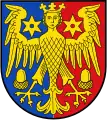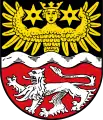Cirksena
The House of Cirksena (East Frisian: [tsɪ:rzəŋ̍ə]) was the name of the ruling family of East Frisia (German: Ostfriesland). They descended from a line of East Frisian chieftains from Greetsiel.
.svg.png.webp)

East Frisia
In 1439, in the wake of clashes between different lines of chieftains, the town of Emden was first placed by Hamburg under direct rule and then, in 1453, given to the Cirksena. The family administered and ruled the town until 1595.
The Cirksena gained strength and succeeded the chieftain line of the tom Broks, after their opponent Focko Ukena was defeated and expelled by several allied chieftains, led by Edzard Cirksena. Ulrich Cirksena (d. 1466) was elevated to the rank of imperial count by Emperor Frederick III and enfeoffed with the Imperial County of East Frisia.
The most important ruler from the House of Cirksena was Edzard I (1462–1528), under whose leadership the Imperial County of East Frisia reached its greatest extent. During his reign, the Reformation spread throughout East Frisia. In 1654, the Cirksena were elevated to princes by the emperor. Charles Edzard, the last ruler from the House of Cirksena, died without issue during the night of 25/26 May 1744 (reportedly from a glass of buttermilk, which he is said to have drunk after a hunt). Immediately thereafter, the state was taken over by Frederick the Great.
Rietberg
The Cirksena provided the County of Rietberg rulers from 1581 to 1699. This initially happened as a personal union with East Frisia after Count Enno III had married Rietberg's daughter-heir, Walburg von Rietberg. In the Treaty of Berum (1600), however, he ceded the County of Rietberg to his daughters.
In 1601, Enno's brother, Count John III, married his niece, Sabina Catherine, Enno's daughter and heiress of Rietberg, with papal dispensation. Both were converted to Catholicism, and the Catholic branch line of the House of Cirksena was founded. The last male descendant of the House of East Frisia in Rietberg, Count Ferdinand Maximilian, died in 1687. His heiress, Maria Ernestine Francisca, married Maximilian Ulrich von Kaunitz in 1699.
Coat of arms

The coat of arms of the family of Cirksena displays a crowned, golden harpy (or angel) on a black field. This motif appears in a variety of successor coats of arms; for example, in the final comital coat of arms of East Frisia, which Count Rudolf Christian adopted in 1625. Here, the harpy is in the upper left of the shield. This coat of arms is still used today as the emblem of East Frisia.
The upper half of Emden's coat of arms also depicts the Cirksena harpy. Until the Emden Revolution in 1595, the Cirksena resided in the town of Emden. Even the Dutch town of Delfzijl opposite Emden incorporated the Cirksena coat of arms into its own. This goes back to the rule of Edzard the Great in Groningerland. Likewise, the harpy is part of the coat of arms of Aurich district, albeit in a different colour, which also goes back to the Cirksena. Even the present-day municipality of Krummhörn, where the ancestral homeland of the Cirksena lay, has the family's coat of arms in its municipal shield.
After the Cirksena had taken over the reins of power in the County of Rietberg, their emblem was also found in Rietberg's coat of arms, between the coat of arms of the old ruling family and that of the Harlingerland. It was later supplemented by the Kaunitz family's coat of arms.
Through the link between East Frisia and Rietberg, the Cirksena harpy is still part of the coat of arms of the Principality of Liechtenstein, albeit in the reverse colours (black and gold), at the bottom right (heraldic: bottom left). Gundakar of Liechtenstein had married Agnes Cirksena, the second daughter of Count Enno III and Walburgis of Rietberg, and had a claim to Rietberg as a result.
 Cirksena coat of arms
Cirksena coat of arms.svg.png.webp) Coat of arms of East Frisia
Coat of arms of East Frisia Emden coat of arms
Emden coat of arms Coat of arms of Delfzijl
Coat of arms of Delfzijl Coat of arms of Aurich district
Coat of arms of Aurich district
 Coat of arms of the Kaunitz-Rietberg family
Coat of arms of the Kaunitz-Rietberg family Coat of arms of Krummhörn
Coat of arms of Krummhörn
Origin of the name
The name Cirksena is of Frisian origin and is still a widespread family name in East Frisia today. It probably goes back to the old forename Tzirk (Cirk). Enno Attena took over the respectable name on his marriage to the daughter-heir, Gela Syardsna of Manslagt.
Genealogy
Syert/Syrt/Syrtatus, Captain of Norden, +after 1255; m. NN Aldersna; They had issue: A1. Enno, +after 1280; m. N van Norden
B1. Sitat, Captain of Norden, +after 1310
C1. Enno, Captain of Norden, +after 1340
D1. Sitat (?), +after 1400; m. Frouwa N (+after 1437)
D2. a daughter; m. Hylo Atena, Captain of Norden (+after 1367)
D3. a daughter; m. Affo Beninga van Pirsum, heer van Bersum (+1402)
D4. a daughter
D5. Frouwa, +after 1437
B2. Idzerd, Captain of Appingen, +after 1312; m. Etta van Visquard (+after
1312)
C1. Enno, Captain of Appingen, +after 1350; m. Adda van Groothusen
D1. Etta; m. Hera Attena, heer van Dornum (+after 1410)
D2. Idzerd, Captain of Appingen, +1406; 1m: Doda ten Book, dau.of Keno
Hilmersna; 2m: N.von Engena (?)
E1. Enno
E2. Imel, Captain of Eilsum, +after 1404
F1. Sibrand, Captain of Eilsum, +4.4.1465
E3. Haro, +after 1408
E4. Enno, Captain of Norden, Greetsiel, Berva and Pilsum, +ca 1450; 1m:
Gela Beningna von Manslagt (+after 1429); 2m: Ellen Sytzena, dau.of
Affo Beninga van Pilsum, heer van Bersum en Tiadeke (+1450), widow of
Ewo van Westerhusen
F1. [1m.] Frouwa; 1m: Sibet Attena (+1433); 2m: Eppo Gokkinga
(+after 1437)
F2. Edzard, Judge of Frisia, +after 1441; 1m: Moeder Ennosna
(+1438); 2m: Frouwe, dau.of Ewo von Westerhusen and Ellen Sytzena
F3. Ulrich I, Statolder of Ostfriesland (1454–64), 1st Graf von
Ostfriesland (1464–66), +27.9.1466; 1m: Foelke van Esens (+1452);
2m: 1453 Theda Ukena, dau.of Uko van Oldersum (*ca 1434,+17.9.1494)
G1. [2m.] Hebe, *18.11.1457, +1476/78; m. Gf Erich I von Schaumburg-
Pinneberg (*1420, +24/25.3.1492)
G2. Gela, *1458, +1497
G3. Enno I, Graf von Ostfriesland (1466–91), *1.6.1460,+drowned 22.2.1491
G4. Edzard I, Graf von Ostfriesland (1491-1528), *15.2.1462,+15.2.1528;
m. 8.7.1498 Elisabeth Gfn von Rietberg, dau.of GfJohann I von Rietberg
by Margarethe zur Lippe (*ca 1475,+13.7.1512)
H1. Ulrich, Graf von Ostfriesland(1528–32),Valet of Emperor Maximilian I,
*1499, +in madness 1532
H2. Margarete, *1500, +Altenwildungen 15.7.1537; m. Emden 17.2.1523
Gf Philipp IV von Waldeck-Wildungen (*1493 +1574)
H3. Theda, *1502, +1563
H4. Enno II, Graf von Ostfriesland (1532–40), *VIII.1505,+24.9.1560;
m. 6.3.1530 Anna von Oldenburg (*14.11.1501,+10.11.1575)
H5. Johann, heer van Falkenburg, Durbuy en Halem, *1506 +Schloss
Falkenburg 6.6.1572; m. 11.11.1539 Dorothea von Habsburg, heiress
of Falkenburg, Durbuy and Halem, illegitimate dau. of Emperor Maximilian I (*1516 +1572)
I1. Maximilian, heer van Falkenburg, Durbuy en Halem,*1542, +ca 1603;
m. 14.9.1564 Barbara de Lalaing
J1. Christoph, heer van Falkenburg, Durbuy en Halem, +1636
J2. Dorothea, +1604; m. before 1.4.1592 Jacob t'Serclaes, Gf von
Tilly et baron de Marbais (*1564, +11.10.1624)
J3. Katharina Maria; m. François de Rye, marquis de Varambon
J4. Louise, *ca 1565, +16.10.1607; m. 5.5.1601 Evrad de Limburg, baron de
Barbançon (+31.12.1608)
I2. Anna; m. Jodocus van Bronckhorst, Gf von Gronsfeld and Limburg
(+1588/89)
I3 Gisela; m. Heinrich van Hahnsberg, Heer van Bruck (+1590)
H6. Anna, +1530
H7. Armgard, +1559
G5. Uko, *1463, +1507
G6. Almuth, *1465, +1522/23; m. Engelmann von Horstell
F4. Adda, +ca 1470; m. Weren't Maninga von Bersum (+1450)
F5. [2m.] Tiadeke, *1438 ?, +after 1470
E5. [2m.] Doda; m.Reduard Hyetsna, heer van Groothusen
C2. Sibrand, Captain of Eilsum, +after 1379; m.N von Ilsum (?)
D1. a son van Eilsum
A2. Merten, +after 1288; m. N von Berum
B1. Omptat, +after 1310
C1. Merten, +after 1367/78
D1. Omptat van Bersum, +after 1378
D2. Olrik van Bersum, +after 1373
D3. Bojo
D4. [parentage uncertain] Tiadeke, +after 1409;1402 m. Affo Beninga von
Pilsum Lord of Bersum (+1402)
See also
Sources
- Hobbing, Hans Heinrich (1915). Die Begründung der Erstgeburtsnachfolge im ostfriesischen Grafenhaus der Cirksena. Aurich(Abhandlungen und Vorträge zur Geschichte Ostfrieslands, 19)
- Reimers, Heinrich (1925) Ostfriesland bis zum Aussterben seines Fürstenhauses. Bremen
- Esselborn, Ernst (1945). Das Geschlecht Cirksena. Berlin
External links
 Media related to House of Cirksena at Wikimedia Commons
Media related to House of Cirksena at Wikimedia Commons